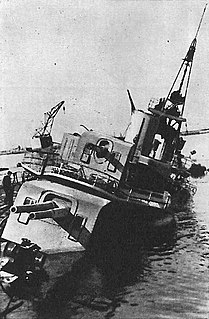

ORP Dzik was a Foxtrot-class submarine, in service with the Polish Navy from 1988 to 2003. [1] It was built in 1966 in the Soviet Union. [2] It was scrapped in May 2005, though the fairwater was preserved.


ORP Dzik was a Foxtrot-class submarine, in service with the Polish Navy from 1988 to 2003. [1] It was built in 1966 in the Soviet Union. [2] It was scrapped in May 2005, though the fairwater was preserved.

The European Theatre of World War II opened with the German invasion of Poland on Friday September 1, 1939, followed by the Soviet invasion of Poland on September 17, 1939. On 6 October, following the Polish defeat at the Battle of Kock, German and Soviet forces gained full control over Poland. The success of the invasion marked the end of the Second Polish Republic, though Poland never formally surrendered. A Polish Underground State with a government-in-exile that would eventually set up headquarters in London resumed the struggle against the occupying powers. The Polish forces in the West, as well as in the East and an intelligence service were established outside of Poland, and contributed to the Allied effort throughout the war.

ORP Błyskawica (Lightning) is a Grom-class destroyer which served in the Polish Navy during World War II. It is the only Polish Navy ship to have been decorated with the Virtuti Militari, Poland's highest military order for gallantry, and in 2012 was given the Pro Memoria Medal. Błyskawica is preserved as a museum ship in Gdynia and is the oldest preserved destroyer in the world. Błyskawica is moored next to the Dar Pomorza.

The Battle of Danzig Bay took place on 1 September 1939, at the beginning of the invasion of Poland, when Polish Navy warships were attacked by German Luftwaffe aircraft in Gdańsk Bay. It was the first naval-air battle of World War II.
ORP Gryf was a school and hospital ship of the Polish Navy, a second vessel to bear that name. She was built in German-occupied Denmark as a cargo ship in 1944, shortly before the end of World War II and initially named Irene Oldendorff. Soon after the capitulation of Germany, she was taken by the United Kingdom, passed to the Ministry of War Transport (MoWT) and renamed Empire Contees, but in 1946 it was given to the Soviet Union as part of that country's war reparations from Germany. Renamed Omsk (Омск), she served in the Soviet merchant fleet until 1947 when she was sold to Poland.

ORP Dzik (Boar) was a U-class submarine built by Vickers-Armstrong at Barrow-in-Furness. She was laid down on 30 December 1941 as P-52 for the Royal Navy, but was transferred to the Polish Navy during construction. Launched on November 11, 1942, ORP Dzik was commissioned into the Polish Navy on December 12, 1942. Her name meant "Wild Boar" in Polish.

ORP Sokół was a U-class submarine built by Vickers-Armstrong at Barrow-in-Furness. Shortly after launching in September 1940 she was to be commissioned by the Royal Navy as HMS Urchin, but instead was leased to the Polish Navy due to a lack of experienced submarine crews. A sister boat to Dzik, both boats operated in the Mediterranean from Malta, where they became known as the "Terrible Twins".

ORP Warszawa was a large guided missile destroyer of the Polish Navy, one of the last ships of the modified Kashin class.

Dzik is a 4.5-ton Polish-made multi-purpose infantry mobility vehicle. Produced by the AMZ works in Kutno, it is designed for serving both the patrol and intervention roles, as well as an armoured personnel carrier for use by various peace-keeping and policing forces. Its armour provides defence against 7.62 mm bullets. The Dzik-3 also boasts bulletproof windows, puncture-proof tires and smoke launchers.
Dzik, wild boar in Polish, may refer to:

The Polish Armed Forces in the West refers to the Polish military formations formed to fight alongside the Western Allies against Nazi Germany and its allies during World War II. Polish forces were also raised within Soviet territories; these were the Polish Armed Forces in the East.
Five ships of the Danish Royal Navy have borne the name HDMS Springeren:

The Polish Navy is a military branch of the Polish Armed Forces responsible for naval operations. The Polish Navy consists of 48 ships and about 12,000 commissioned and enlisted personnel. The traditional ship prefix in the Polish Navy is ORP.

Bolesław Romanowski was a submarine commander of the Polish Navy during World War II.

Borys Karnicki was a submarine commander of the Polish Navy during World War II.

The 10th Submarine Flotilla was formed during the First World War. In January 1915 it was based on the Humber but by January 1917 it had relocated to the Tees. During the Second World War it was formed at Malta in January 1941 and comprised Royal Navy and Polish Naval Force submarines assigned to the British Mediterranean Fleet based in Malta from early 1941.
Dzik has been the name of three ships of the Polish Navy:

ORP Gniezno is a Lublin-class minelayer-landing ship of Polish Navy named after the city of Gniezno.

ORP Kraków is a Lublin-class minelayer-landing ship of Polish Navy named after the city of Kraków.